Question 1.
In right angle triangle ABC, 8 cm, 15 cm and 17 cm are the lengths of AB, BC and CA respectively. Then, find out sin A, cos A and tan A.
Answer:
Given that
△ABC is a right angle triangle and Lengths of AB, BC and CA are 8 cm, 15 cm and 17 cm respectively.
Among the given lengths CA is longest.
Hence CA is the hypotenuse in △ABC and its opposite vertex having right angle.
i.e., ∠B = 90°.
With reference to ∠A, we have opposite side = BC = 15 cm
adjacent side = AB = 8 cm
and hypotenuse = AC = 17

sin A = Opposite side of ∠A/Hypotenuse = BC/AC = 15/17
cos A = Adjacent side of ∠A/Hypotenuse = AB/AC = 8/17
tan A = Opposite side of ∠A/Adjacent side of ∠A = BC/AB = 15/8
∴ sin A = 1517;
cos A = 817
tan A = 158
Question 2.
The sides of a right angle triangle PQR are PQ = 7 cm, QR = 25 cm and ∠P = 90° respectively. Then find, tan Q - tan R.
Answer:

Given that △PQR is a right angled triangle and PQ = 7 cm, QR = 25 cm.
By Pythagoras theorem QR2= PQ2+ PR2
(25)2= (7)2+ PR2
PR2= (25)2 - (7)2= 625 - 49 = 576
PR = √576 = 24 cm
tan Q =PR/PQ=24/7;
tan R =PQ/PR=7/24
∴ tan Q - tan R =24/7 - 7/24
=(24)2?(7)2/168
=576?49/168
=527/168
Question 3.
In a right angle triangle ABC with right angle at B, in which a = 24 units, b = 25 units and ∠BAC = θ. Then, find cos θ and tan θ.
Answer:
Given that ABC is a right angle triangle with right angle at B, and BC = a = 24 units, CA = b = 25 units and ∠BAC = θ.

By Pythagoras theorem
AC2= AB2+ BC2
(25)2= AB2+ (24)2
AB2= 252 - 242= 625 - 576
AB2= 49
AB = √49 = 1
With reference to ∠BAC = θ, we have
Opposite side to θ = BC = 24 units.
Adjacent side to θ = AB = 7 units.
Hypotenuse = AC = 25 units.
Now
cos θ = Adjacent side of θ /Hypotenuse = AB/AC = 7/25
tan θ = Opposite side of θ /Adjacent side of θ = BC/AB = 24/7
Hence cos θ = 7/25 and tan θ = 24/7
Question 4.
If cos A = 12/13, then find sin A and tan A.
Answer:
From the identity
sin2A + cos2A = 1
⇒ sin2A = 1 - cos2A
= 1 - (12/13)2
= 1 - 144/169
=169-144/169
=25/169
∴ sin A = √25/169 = 5/13

∴ sin A =5/13; tan A =5/12
Question 5.
If 3 tan A = 4, then find sin A and cos A.
Answer:
Given 3 tan A = 4
⇒ tan A =4/3
From the identify sec2A - tan2A = 1
⇒ 1 + tan2A = sec2A

If cos A =3/5 then from
sin2A + cos2A = 1
We can write sin2A = 1 - cos2A
= 1 -(3/5)2
= 1 - 9/25
⇒ sin2A =16/25
⇒ sin A =4/5
∴ sin A =4/5; cos A =3/5
Question 6.
In △ABC and △XYZ, if ∠A and ∠X are acute angles such that cos A = cos X then show that ∠A = ∠X.
Answer:

In the given triangle, cos A = cos X
⇒AC/AX = XC/AX
⇒ AC = XC
⇒ ∠A = ∠X ( ∵ Angles opposite to equal sides are also equal)
Question 7.
Given cot θ =7/8, then evaluate

Answer

cot2θ = (cot θ)2
=(7/8)2=49/64 …… (1)

= sec θ + tan θ
So cot θ =7/8
⇒ tan θ =8/7
⇒ tan2θ =(87)2=64/49
From sec2θ - tan2θ = 1
⇒ 1 + tan2θ = sec2θ

Question 8.
In a right angle triangle ABC, right angle is at B, if tan A = √3, then find the value of
i) sin A cos C + cos A sin C
ii) cos A cos C - sin A sin C
Answer:
Given, tan A =√3/1
Hence Opposite side/Adjacent side=√3/1
Let opposite side = √3k and adjacent side = 1k

In right angled △ABC,
AC2= AB2+ BC2
(By Pythagoras theorem)
⇒ AC2= (1k)2+ (√3k)2
⇒ AC2= 1k2+ 3k2
⇒ AC2= 4k2
∴ AC =√4k2= 2k

Question 1.
Evaluate the following.
i) sin 45° + cos 45°
Answer:
sin 45° + cos 45°

ii)

Answer

iii)

Answer

iv) 2 tan245° + cos230° - sin260°
Answer:
2 tan245° + cos230° - sin260°

v)

Answer

Question 2.
Choose the right option and justify your choice.
i)2tan30°/1+tan245°
a) sin 60°
b) cos 60°
c) tan 30°
d) sin 30°
Answer:

ii) 1?tan245°/1+tan245°
a) tan 90°
b) 1
c) sin 45°
d) 0
Answer:
1?tan245°/1+tan245° = 1?(1)2/1+(1)2
= 0/1+1 = 0/2 = 0
iii) 2tan30°/1?tan230°
a) cos 60°
b) sin 60°
c) tan 60°
d) sin 30°
Answer:

Question 3.
Evaluate sin 60° cos 30° + sin 30° cos 60°. What is the value of sin (60° + 30°). What can you conclude?
Answer:
Take sin 60°.cos 30° + sin 30°.cos 60°

Now take sin (60° + 30°)
= sin 90° = 1 .... (2)
From equations (1) and (2), I conclude that
sin (60°+30°) = sin 60° . cos 30° + sin 30° . cos 60°.
i.e., sin (A + B) = sin A . cos B + cos A . sin B
Question 4.
Is it right to say cos (60° + 30°) = cos 60° cos 30° - sin 60° sin 30° ?
Answer:
L.H.S. = cos (60° + 30°)
cos 90° = 0
R.H.S. = cos 60° . cos 30° - sin 60° . sin 30°.

Yes, it is right to say
cos (60°+30°) = cos 60° . cos 30° - sin 60° . sin 30°.
i.e., cos (A + B) = cos A . cos B - sin A . sin B
Question 5.
In right angle triangle △PQR, right angle is at Q and PQ = 6 cms, ∠RPQ = 60°. Determine the lengths of QR and PR.
Answer:
Given that △PQR is a right angled triangle, right angle is at Q and PQ = 6 cm, ∠RPQ = 60°.

tan 60° = Opposite side to ∠P/Adjacent side to ∠P
√3 = RQ/6
which gives RQ = 6√3 cm ... (1)
To find the length of the side RQ, we consider

∴ The length of QR is 6√3 and RP is 12 cm.
Question 6.
In △XYZ, right angle is at Y, YZ = x, and XY = 2x then determine ∠YXZ and ∠YZX.
Answer:
Note: In the problem take
YX = x, and XZ = 2x.

Given that △XYZ is a right angled triangle and right angle at Y, and YX = x and XZ = 2x.
By Pythagoras theorem
XZ2 = XY2 + YZ2
(2x)2 = (x)2 + YZ2
4x2 = x2 + YZ2
YZ2 = 4x2 - x2 = 3x2
YZ = √3x2 = √3x
Now, from the △XYZ
tan X = XZ/XY = √3x/x
tan X = √3 = tan 60°
∴ Angle YXZ is 60°.
tan Z = XY/YZ = x/√3x
tan Z = 1/√3 = tan 30°
∴ Angle YZX is 30°.
Hence ∠YXZ and ∠YZX are 60° and 30°.
Question 7.
Is it right to say that
sin (A + B) = sin A + sin B? Justify your answer.
Answer:
Let A = 30° and B = 60°
L.H.S = sin (A + B)
= sin (30° + 60°) = sin 90° = 1
R.H.S = sin 30° + sin 60°
= 1/2 + √3/2
= √3+1/2
Hence L.H.S ≠ R.H.S
So, it is not right to say that sin (A + B) = sin A + sin B
Question 1.
Evaluate:
i) tan36°/cot54°
Answer:
Given that tan36°/cot54°
= tan36°/cot(90°?36°) [∵ cot (90 - θ) = tan θ]
= tan36°/tan36°
= 1
ii) cos 12° - sin 78°
Answer:
Given that cos 12° - sin 78°
= cos 12° - sin(90° - 12°) [∵ sin (90 - θ) = cos θ]
= cos 12° - cos 12° = 0
iii) cosec 31° - sec 59°
Answer:
Given that cosec 31° - sec 59°
= cosec 31° - sec (90° - 31°) [∵ sec (90 - θ) = cosec θ]
= cosec 31° - cosec 31° = 0
iv) sin 15° sec 75°
Answer:
Given that sin 15° sec 75°
= sin 15° . sec (90° - 15°)
= sin 15° . cosec 15° [∵ sec (90 - θ) = cosec θ]
= sin 15° . 1/sin15° [∵ cosec θ = 1sinθ]
= 1
v) tan 26° tan 64°
Answer:
Given that tan 26° tan 64°
= tan 26° . tan (90° - 26°)
= tan 26° . cot 26° [∵ tan (90 - θ) = cot θ]
= tan 26° . 1/tan26° [∵ cot θ = 1tanθ]
= 1
Question 2.
Show that
i) tan 48° tan 16° tan 42° tan 74° = 1
Answer:
L.H.S. = tan 48° tan 16° tan 42° tan 74°
= tan 48°. tan 16° . tan(90° - 48°) . tan(90° - 16°)
= tan 48° . tan 16° . cot 48° . cot 16° [∵ tan (90 - θ) = cot θ]
= tan 48° . tan 16° . 1/tan48° . 1/tan16° [∵ cot θ = 1/tanθ]
= 1 = R.H.S.
∴ L.H.S. = R.H.S.
ii) cos 36° cos 54° - sin 36° sin 54° = 0
Answer:
L.H.S. = cos 36° cos 54° - sin 36° sin54°
= cos (90° - 54°) . cos (90° - 36°) - sin 36° . sin 54° [∵ cos (90 - θ) = sin θ]
= sin 54° . sin 36° - sin 36° . sin 54°
= 0 = R.H.S.
∴ L.H.S. = R.H.S.
Question 3.
If tan 2A = cot (A - 18°), where 2A is an acute angle. Find the value of A.
Answer:
Given that tan 2A = cot (A - 18°)
⇒ cot (90° - 2A) = cot (A - 18°) [∵ tan θ = cot (90 - θ)]
⇒ 90° - 2A = A - 18°
⇒ 108° = 3A
⇒ A = 108°/3 = 36°
Hence the value of A is 36°.
Question 4.
If tan A = cot B where A and B. are acute angles, prove that A + B = 90°.
Answer:
Given that tan A = cot B
⇒ cot (90° - A) = cot B [∵ tan θ = cot (90 - θ)]
⇒ 90° - A = B
⇒ A + B = 90°
Question 5.
If A, B and C are interior angles of a triangle ABC, then show that tan(A+B/2)=cot C/2
Answer:
Given A, B and C are interior angles of right angle triangle ABC then A + B + C = 180°.
On dividing the above equation by ‘2’ on both sides, we get 180°

On taking tan ratio on both sides
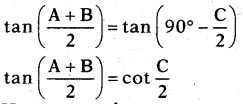
Hence proved.
Question 6.
Express sin 75° + cos 65° in terms of trigonometric ratios of angles between 0° and 45°.
Answer:
We have sin 75° + cos 65°
= sin (90° - 15°) + cos (90° - 25°)
= cos 15° + sin 25° [∵ sin (90 - θ) = cos θ and cos (90 - θ) = sin θ]
Question 1.
Evaluate the following:
i) (1 + tan θ + sec θ) (1 + cot θ - cosec θ)
Answer:
Given (1 + tan θ + sec θ) (1 + cot θ - cosec θ)

ii) (sin θ + cos θ)2+ (sin θ - cos θ)2
Answer:
Given (sin θ + cos θ)2+ (sin θ - cos θ)2
= (sin2θ + cos2θ + 2 sin θ cos θ) + (sin2θ + cos2θ - 2 sin θ cos θ) [∵ (a + b)2= a2+ b2+ 2ab
(a - b)2= a2+ b2- 2ab]
= 1 + 2 sin θ cos θ + 1 - 2 sin θ cos θ [∵ sin2θ + cos2θ = 1]
= 1 + 1
= 2
iii) (sec2θ - 1) (cosec2θ - 1)
Answer:
Given (sec2θ - 1) (cosec2θ - 1)
= tan2θ × cot2θ [∵ sec2θ - tan2θ = 1; cosec2θ - cot2θ = 1]
= tan2θ × 1/tan2θ = 1
Question 2.
Show that (cosec θ - cot θ)2 = 1?cosθ/1+cosθ
Answer:
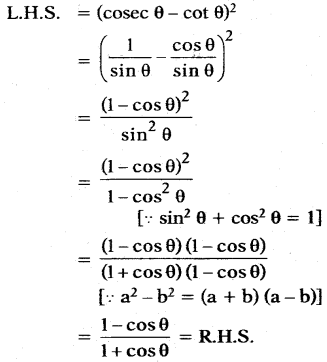
Question 3.
Show that √1+sinA/1?sinA = sec A + tan A
Answer:
Given that L.H.S. =√1+sin A/1?sin A
Rationalise the denominator, rational factor of 1 - sin A is 1 + sin A.
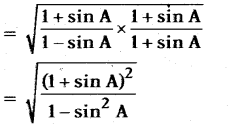


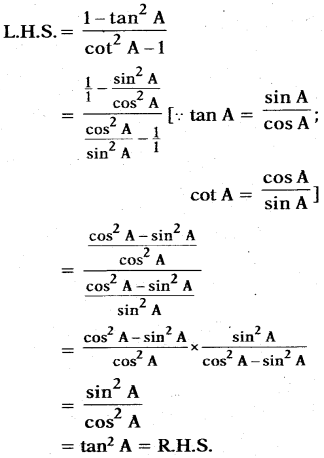
Question 5.
Show that 1/cosθ - cos θ = tan θ - sin θ.
Answer:

Question 6.
Simplify sec A (1 - sin A) (sec A + tan A)
Answer:
L.H.S. = sec A (1 - sin A) (sec A + tan A)
= (sec A - sec A . sin A) (sec A + tan A)
= (sec A - 1/cosA . sin A) (sec A + tan A)
= (sec A - tan A) (sec A + tan A)
= sec2 A - tan2 A [∵ sec2 A - tan2 A = 1]
= 1
Question 7.
Prove that (sin A + cosec A)2+ (cos A + sec A)2= 7 + tan2A + cot2A
Answer:
L.H.S. = (sin A + cosec A)2+ (cos A + sec A)2
= (sin2A + cosec2A + 2 sin A . cosec A) + (cos2A - sec2A + 2 cos A . sec A) [∵ (a + b)2= a2+ b2+ 2ab]
= (sin2A + cos2A) + cosec2A + 2 sin A .1/sinA+ sec2A + 2 cos A .1/cosA
[∵1/sinA= cosec A;1/cosA= sec A]
= 1 +(1 + cot2A) + 2 + (1 + tan2A) + 2
[∵ sin2A + cos2A = 1; cosec2A = 1 + cot2A; sec2A = 1 + tan2A]
= 7 + tan2A + cot2A
= R.H.S.
Question 8.
Simplify (1 - cos θ) (1 + cos θ) (1 + cot2θ)
Answer:
Given that
(1 - cos θ) (1 + cos θ) (1 + cot2θ)
= (1 - cos2θ) (1 + cot2θ)
[∵ (a – b) (a + b) = a2- b2]
= sin2θ. cosec2θ [∵ 1 - cos2θ = sin2θ; 1 + cot2θ = cosec2θ]
= sin2θ .1/sin2θ[∵ cosec θ =1/sinθ]
= 1
Question 9.
If sec θ + tan θ = p, then what is the value of sec θ - tan θ?
Answer:
Given that sec θ + tan θ = p ,
We know that sec2θ - tan2θ = 1
sec2θ - tan2θ = (sec θ + tan θ) (sec θ - tan θ)
= p (sec θ - tan θ)
= 1 (from given)
⇒ sec θ - tan θ =1/p
Question 10.
If cosec θ + cot θ = k, then prove that cos θ =k2?1/k2+1
Answer:
Method-I:
Given that cosec θ + cot θ = k
R.H.S. =k2?1/k2+1
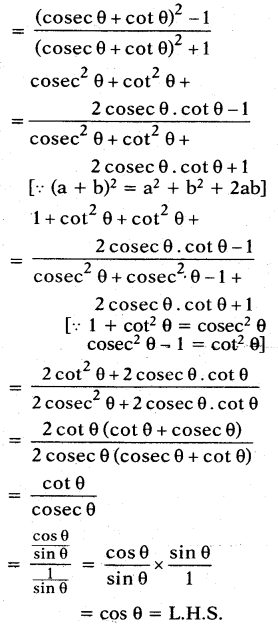
Method ? II:
Given that cosec θ + cot θ = k ……..(1)
We know that cosec2θ ? cot2θ = 1
⇒ (cosec θ + cot θ) (cosec θ ? cot θ) = 1 [∵ a2? b2= (a -b)(a + b)]
⇒ k (cosec θ ? cot θ) = 1
⇒ (cosec θ ? cot θ) =1k
By solving (1) and (2)
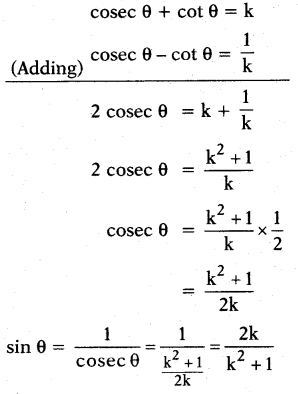
According to identity cos2θ + sin2θ = 1
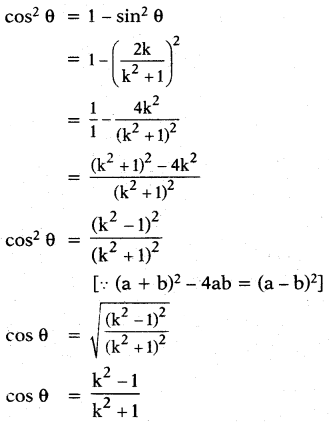
Hence proved.